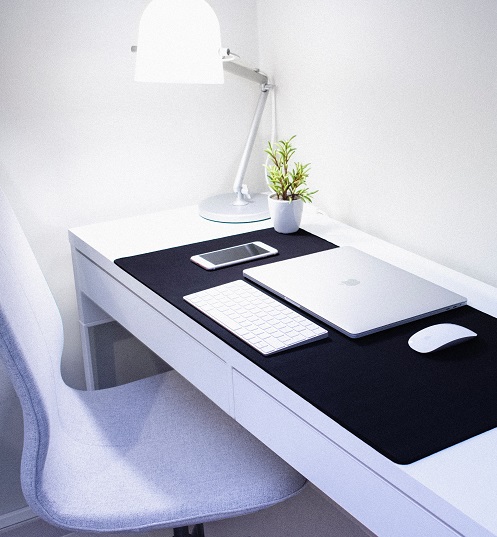4 Simple Rules To An Organized Desk
By Pamela Wong
Pamela is a Trained Professional Organizer based in Oakville, Ontario and is the owner of Zen N Organized. She helps homeowners and small business owners transform their homes and home offices into organized spaces. She has a practical, non-judgemental approach to organizing. Her objective is to create functional and harmonious spaces for her clients.

In the last couple of months, our physical setting may have changed from the office to working from home, but our business goals remain the same. We have to make sure that our work gets done no matter what.
Do you have a location in your home with your office space set up with a desk, comfortable chair and proper lighting? But is your desk lacking organization? Does it take too long to find what you are looking for and do you have supplies piled up in the corner?
If your answer is yes, then here some rules to help you create an organized desk:
RULE #1 – REDUCE DISTRACTIONS
Distractions is one of the biggest complaints about working from home. Besides your children and pets wanting attention or your significant other going on a conference call, distractions may also come from unrelated documents scattered around your desk.
The key is to identify your distractions and convert your space to a business only area. This will reduce the confusion and disorganization right away. If the item doesn’t belong in your office area, then keep it out! Add a level of privacy by locking up your business documents so your children would not accidentally get their hands on them.
You can also decrease clutter, a form of distraction, by following these simple methods:
- Use only one to-do list – consolidate all the sticky notes or scrap papers on the desk that serve as reminders onto one list;
- Containerize and use drawer dividers for pens, paper clips; use in/out paper tray;
- Gather all papers, then sort, categorize and file on a regular basis. Keep files vertical to save space.
- Have set times for reading and responding to emails so that you can focus on the task at hand.

RULE #2 – PRODUCTIVE WORKFLOW AT YOUR DESK
One of the requirements for a productive workflow is a functional desk. Your desk is prime real estate so you should only keep items that you need and use here. Determine the best layout of items on your desk based on things such as lighting, whether you left- or right-handed, items that you use most often, and ample power outlets.
If you have 2 drawers in your desk, use the first drawer for stationery and the second drawer for current project file and action items.
If you have wall space close by, you can add visual interests by hanging a picture, floating shelf or a pin board.

RULE #3 – SET A SCHEDULE TO READ AND TO FINISH OUTSTANDING ACTION ITEMS
Two of the most common issues with my clients are their reading material and incoming paper. Things like books that are purchased but not yet read, magazines and newspaper cut outs, bookmarked websites, incoming mail, research materials all need to be dealt with. To conquer this list, I strongly recommend setting a schedule and a deadline:
- Set a schedule for the “must read” and incoming paper that needs to be dealt with. Allocate time in your daily/weekly task list
- Set a 3-month deadline for the “would like to read”. After 3 months, delete/recycle any outstanding materials.

RULE #4 – SET A ROUTINE
Take the last 5-10 minutes of your day to clear off your desk so that you start with a clean and organized desk the next morning. It is always nicer to start your day with a positive energy than a negative one.

I truly believe that if you spend the time and follow these 4 rules it will help to reduce stress, meet deadlines and increase your productivity.
You can find information about filing and ways to be more productive in my other posts.
Are You Filing the Right Way?
Simple Practices to Help You Be More Productive
Pam @ Zen N Organized




I have always struggled with #3. If I don’t read something right away, it usually sits for months or even years before I do something about it.
Janet, you are in the same boat with a lot of my clients. Scheduling reading time and deadline dates seem to really help reduce the “reading pile”. Give it a try and let me know how it works.